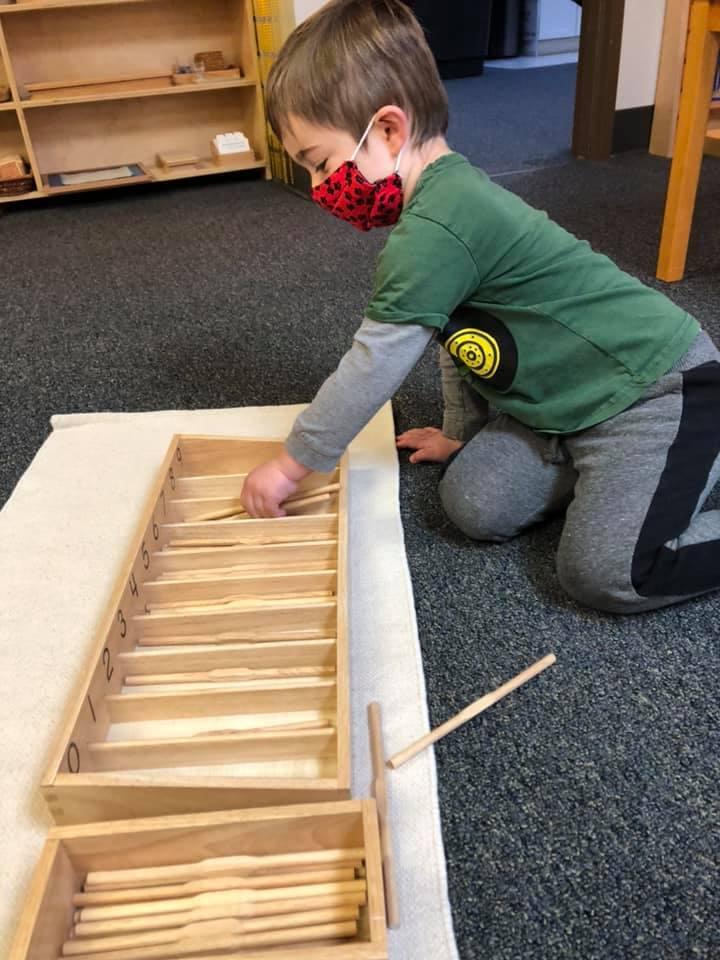
2 minute read
AGES 18 TO 36 MONTHS
The Practical Life lessons are the first level of work for all children and are a link to the child's home environment, aiding adaptation and orientation to the child's society and culture. The materials involve precise movements and procedures, which aid large and fine motor development. The child's attention span and concentration are built up through repeated and complex activities. Sequential and orderly work habits, independence and self-control are established with this area. The early social courtesy behaviors, class procedures and expectations are introduced through Practical Life. This preparation is essential for success in the academic areas.
Care of Self: Dressing/undressing, hand and face washing, independence with personal hygiene, and care of personal belongings.
Advertisement
Care of Environment: Washing and polishing materials and furniture, plant care and flower arrangement, animal care, setting and clearing tables, respecting materials and environment, returning work when finished, and related environmental activities including the outside environment.
Food Preparation: Pouring, slicing, stirring, peeling, grating, spreading and serving
Grace and Courtesy: Social manners, carrying and walking respectfully, words for selfexpression and table manners
Motor Skills and Coordination: Eye-hand coordination, large motor control, spatial awareness and body coordination
The Language materials are incorporated through many daily experiences. The children between birth and six years are in a long sensitive period for language. Language is the means whereby humans become part of the cultural group to which they belong. It is through language that the child acquires the history, social values and behavior of his/her society. The child is continually developing oral language and communication skills. Nurturing this language development prepares the child for later academic work in writing, reading, and grammar.
Oral Language: Listening and communication skills, auditory discrimination, and vocabulary development.
The Sensorial materials isolate a particular quality and refine the sense-perceptual skills. These are materialized abstractions which give the child concrete experiences with concepts and the matching and gradations of size, shape, form, color, texture, sound, and taste The child’s senses are refined and perceptual awareness is intensified. The sensorial materials are a direct preparation for the development of mathematical thinking and the math lessons. Language for the perceptual qualities is concretely represented. Visual: Introduction to colors and corresponding vocabulary, gradation through size, and an introduction to basic geometric forms. Auditory: Matching and gradations of sounds and musical tones and rhythm instruments Gustatory and Olfactory: Experiencing tastes and smells. Tactile: Exploring the environment through touch.
Art Media, Music and Movement nourish the child’s natural sense of creative expression. These activities utilize the same developing skills as found in the Practical Life, Sensorial and Language curriculum areas. As concentration increases, the child brings tasks to completion or to more complexity. The child's creative expression is pure and uncontrolled simplicity which flourishes using an array of media and activities. From experimental painting to representational drawing, from spontaneous singing or dancing to lessons with rhythm instruments and group movements, the child is provided with a rich environment for creative activities. Listening to background music, making interesting sounds, singing together, and moving in tune with the music are examples of the many opportunities to experience music and movement in the Toddler program. Art Media: Drawing and painting materials, gluing, collage and sculpture materials, tearing and cutting. Music and Movement: Singing songs with hand and body movements; walking, dancing, marching with p







